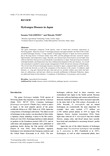Hydrangea Diseases in Japan
Japan Agricultural Research Quarterly
| ISSN | 00213551 |
|---|---|
| NII recode ID (NCID) | AA0068709X |

Full text
jarq57-3_183-194.pdf1.67 MB
The genus Hydrangea comprises 70-80 species, some of which have economic importance as flowering plants. Japan has at least 71 hydrangea diseases and approximately one-third of the world’s recorded hydrangea diseases. A large number of hydrangea diseases in Japan are known primarily due to the long history of disease studies since 1892, and the pathogen diversity caused by Japan’s high humidity and temperature ranges. Recently, new diseases have been found in several high-value cultivars that have been grown as potted plants in greenhouses in Japan. Such growing environments with high humidity and temperature may have enhanced development of the new diseases. An overall risk assessment is needed to ensure proper management of both old and new diseases of hydrangeas. This review lists all known hydrangea diseases recorded in Japan, compared them to global records, and reveals the diversity as well as the uniqueness of the diseases in the country. In addition, eight diseases, i.e., ring spot, bacterial leaf spot, stem and root rot, powdery mildew, gray mold, leaf spot/stem rot, anthracnose, and leaf spot, which are currently problematic in Shimane Prefecture, Japan, are addressed based on four features: 1) symptoms, 2) distribution, 3) occurrence, and 4) control.
| Date of issued | |
|---|---|
| Creator | Susumu NAGASHIMA Motoaki TOJO |
| Subject | disease control distribution pathogen species occurrences |
| Publisher | Japan International Research Center for Agricultural Sciences |
| Received Date | 2022-07-14 |
| Accepted Date | 2022-10-14 |
| Available Online | |
| Volume | 57 |
| Issue | 3 |
| spage | 183 |
| epage | 194 |
| DOI | 10.6090/jarq.57.183 |
| Language | eng |
